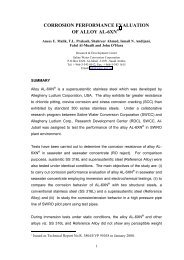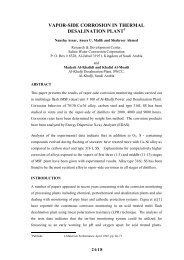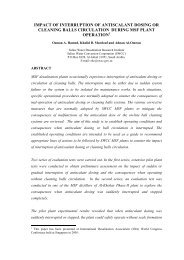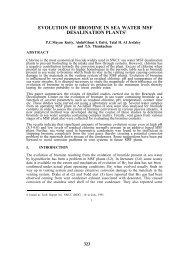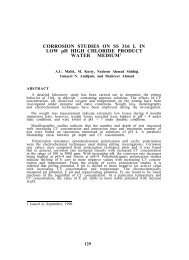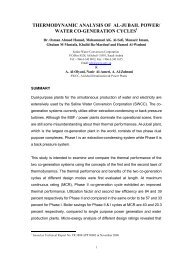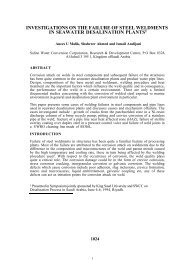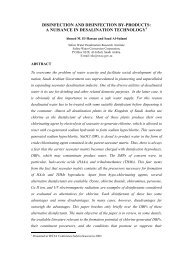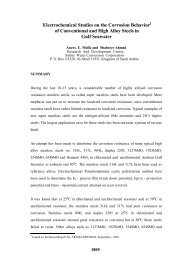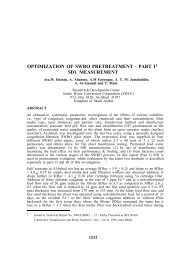performance evaluation of technos cleaning balls in rdc msf pilot
performance evaluation of technos cleaning balls in rdc msf pilot
performance evaluation of technos cleaning balls in rdc msf pilot
You also want an ePaper? Increase the reach of your titles
YUMPU automatically turns print PDFs into web optimized ePapers that Google loves.
alls once received certa<strong>in</strong> wear <strong>in</strong> a particular orientation, keep themselves along the<br />
same axis (due to less resistance) every time they go through a tube.<br />
The consumption <strong>of</strong> the <strong>balls</strong> with time was also <strong>in</strong>vestigated and found that the rate <strong>of</strong><br />
<strong>balls</strong> replacement due to wear and tear was with<strong>in</strong> acceptable limits. Balls started<br />
becom<strong>in</strong>g under-sized after 15 days <strong>of</strong> operation and on completion <strong>of</strong> 30 days <strong>of</strong><br />
operation, 1461 <strong>balls</strong> out <strong>of</strong> the total charge <strong>of</strong> 1600 were found under-sized. The ball<br />
lifetime, however, depends ma<strong>in</strong>ly on distiller size, its configuration and frequency <strong>of</strong><br />
ball <strong>clean<strong>in</strong>g</strong> for a particular ball type. The number <strong>of</strong> <strong>balls</strong> rejected due to under-size <strong>in</strong><br />
each <strong>in</strong>spection is shown <strong>in</strong> Figure 3, while cumulative counts <strong>of</strong> <strong>balls</strong> damaged and<br />
lost with time are plotted <strong>in</strong> Figure 4.<br />
4.2.2 Thermal Performance<br />
The plant <strong>performance</strong> and the br<strong>in</strong>e heater foul<strong>in</strong>g were exam<strong>in</strong>ed dur<strong>in</strong>g the test<br />
period. The plant was unstable dur<strong>in</strong>g the period <strong>of</strong> 50 to 150 hours <strong>of</strong> the test. Figure 5<br />
shows the <strong>performance</strong> <strong>of</strong> the distiller dur<strong>in</strong>g the test period <strong>in</strong>clud<strong>in</strong>g the trends <strong>of</strong><br />
foul<strong>in</strong>g factor and heat transfer coefficient <strong>in</strong> br<strong>in</strong>e heater. Foul<strong>in</strong>g factor fluctuated <strong>in</strong><br />
the range <strong>of</strong> 0.1 to 0.32 m 2 K/kW but most <strong>of</strong> the time rema<strong>in</strong>ed with<strong>in</strong> 0.2 m 2 K/kW,<br />
which is lower than the design service-foul<strong>in</strong>g factor <strong>of</strong> 0.325 m 2 K/kW <strong>in</strong>dicat<strong>in</strong>g the<br />
effectiveness <strong>of</strong> ball <strong>clean<strong>in</strong>g</strong> system. Steady trend <strong>of</strong> foul<strong>in</strong>g factor <strong>in</strong>dicates positive<br />
<strong>performance</strong> <strong>of</strong> Technos <strong>balls</strong>.<br />
Trends <strong>of</strong> ga<strong>in</strong> output ratio (GOR) and <strong>performance</strong> ratio (PR) dur<strong>in</strong>g the test period<br />
revealed that plant <strong>performance</strong> was constant and thus Technos <strong>balls</strong> were effective <strong>in</strong><br />
ma<strong>in</strong>ta<strong>in</strong><strong>in</strong>g the heat transfer surfaces free from any additional scale deposition.<br />
4.2.3 Chemical Analysis<br />
Chemical analyses <strong>of</strong> various br<strong>in</strong>e streams <strong>in</strong> distiller # 9 were carried out daily for<br />
pH, M-alkal<strong>in</strong>ity and chloride contents. These values were found with<strong>in</strong> acceptable<br />
limits. Loss <strong>of</strong> total alkal<strong>in</strong>ity (LTA) and concentration ratio were calculated <strong>in</strong> streams<br />
<strong>of</strong> br<strong>in</strong>e recycle and br<strong>in</strong>e blowdown. Figure 6 shows LTA, M-alkal<strong>in</strong>ity, concentration<br />
ratio and copper content <strong>of</strong> br<strong>in</strong>e blowdown. Cu contents <strong>in</strong> the stream <strong>of</strong> br<strong>in</strong>e<br />
blowdown before and dur<strong>in</strong>g ball <strong>clean<strong>in</strong>g</strong> were found fluctuat<strong>in</strong>g between 7 and 23<br />
ppb, which is with<strong>in</strong> normal limit <strong>of</strong> the Cu content found dur<strong>in</strong>g normal operation.<br />
9



